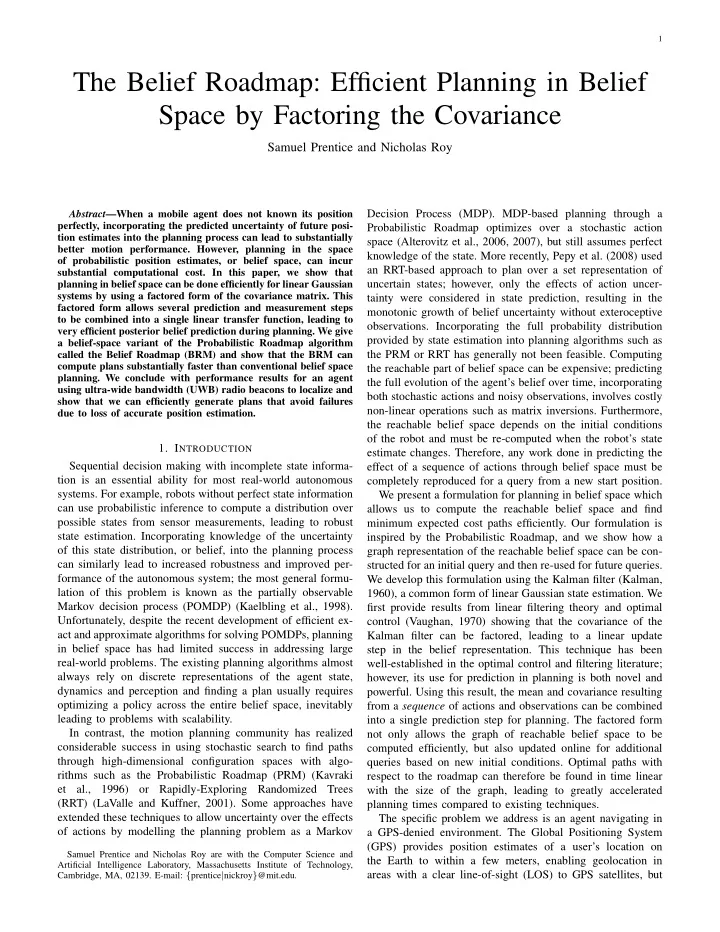

1 The Belief Roadmap: Efficient Planning in Belief Space by Factoring the Covariance Samuel Prentice and Nicholas Roy Abstract —When a mobile agent does not known its position Decision Process (MDP). MDP-based planning through a perfectly, incorporating the predicted uncertainty of future posi- Probabilistic Roadmap optimizes over a stochastic action tion estimates into the planning process can lead to substantially space (Alterovitz et al., 2006, 2007), but still assumes perfect better motion performance. However, planning in the space knowledge of the state. More recently, Pepy et al. (2008) used of probabilistic position estimates, or belief space, can incur an RRT-based approach to plan over a set representation of substantial computational cost. In this paper, we show that uncertain states; however, only the effects of action uncer- planning in belief space can be done efficiently for linear Gaussian systems by using a factored form of the covariance matrix. This tainty were considered in state prediction, resulting in the factored form allows several prediction and measurement steps monotonic growth of belief uncertainty without exteroceptive to be combined into a single linear transfer function, leading to observations. Incorporating the full probability distribution very efficient posterior belief prediction during planning. We give provided by state estimation into planning algorithms such as a belief-space variant of the Probabilistic Roadmap algorithm called the Belief Roadmap (BRM) and show that the BRM can the PRM or RRT has generally not been feasible. Computing compute plans substantially faster than conventional belief space the reachable part of belief space can be expensive; predicting planning. We conclude with performance results for an agent the full evolution of the agent’s belief over time, incorporating using ultra-wide bandwidth (UWB) radio beacons to localize and both stochastic actions and noisy observations, involves costly show that we can efficiently generate plans that avoid failures non-linear operations such as matrix inversions. Furthermore, due to loss of accurate position estimation. the reachable belief space depends on the initial conditions of the robot and must be re-computed when the robot’s state 1. I NTRODUCTION estimate changes. Therefore, any work done in predicting the Sequential decision making with incomplete state informa- effect of a sequence of actions through belief space must be tion is an essential ability for most real-world autonomous completely reproduced for a query from a new start position. systems. For example, robots without perfect state information We present a formulation for planning in belief space which can use probabilistic inference to compute a distribution over allows us to compute the reachable belief space and find possible states from sensor measurements, leading to robust minimum expected cost paths efficiently. Our formulation is state estimation. Incorporating knowledge of the uncertainty inspired by the Probabilistic Roadmap, and we show how a of this state distribution, or belief, into the planning process graph representation of the reachable belief space can be con- can similarly lead to increased robustness and improved per- structed for an initial query and then re-used for future queries. formance of the autonomous system; the most general formu- We develop this formulation using the Kalman filter (Kalman, lation of this problem is known as the partially observable 1960), a common form of linear Gaussian state estimation. We Markov decision process (POMDP) (Kaelbling et al., 1998). first provide results from linear filtering theory and optimal Unfortunately, despite the recent development of efficient ex- control (Vaughan, 1970) showing that the covariance of the act and approximate algorithms for solving POMDPs, planning Kalman filter can be factored, leading to a linear update in belief space has had limited success in addressing large step in the belief representation. This technique has been real-world problems. The existing planning algorithms almost well-established in the optimal control and filtering literature; always rely on discrete representations of the agent state, however, its use for prediction in planning is both novel and dynamics and perception and finding a plan usually requires powerful. Using this result, the mean and covariance resulting optimizing a policy across the entire belief space, inevitably from a sequence of actions and observations can be combined leading to problems with scalability. into a single prediction step for planning. The factored form In contrast, the motion planning community has realized not only allows the graph of reachable belief space to be considerable success in using stochastic search to find paths computed efficiently, but also updated online for additional through high-dimensional configuration spaces with algo- queries based on new initial conditions. Optimal paths with rithms such as the Probabilistic Roadmap (PRM) (Kavraki respect to the roadmap can therefore be found in time linear et al., 1996) or Rapidly-Exploring Randomized Trees with the size of the graph, leading to greatly accelerated (RRT) (LaValle and Kuffner, 2001). Some approaches have planning times compared to existing techniques. extended these techniques to allow uncertainty over the effects The specific problem we address is an agent navigating in of actions by modelling the planning problem as a Markov a GPS-denied environment. The Global Positioning System (GPS) provides position estimates of a user’s location on Samuel Prentice and Nicholas Roy are with the Computer Science and the Earth to within a few meters, enabling geolocation in Artificial Intelligence Laboratory, Massachusetts Institute of Technology, areas with a clear line-of-sight (LOS) to GPS satellites, but Cambridge, MA, 02139. E-mail: { prentice | nickroy } @mit.edu.
Recommend
More recommend